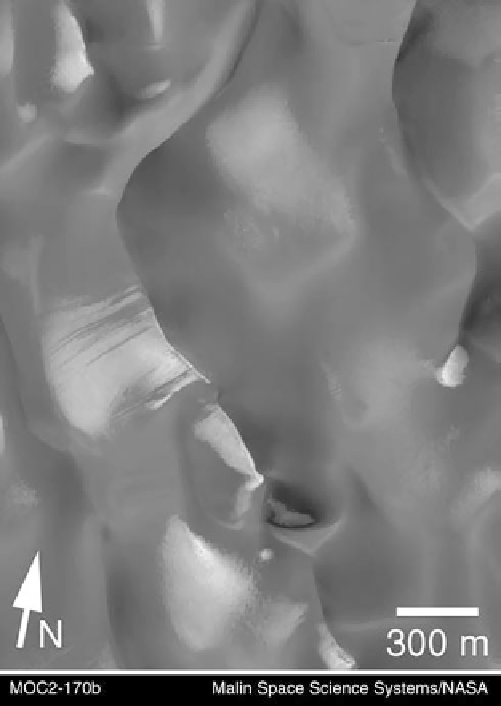Geoscience Reference
In-Depth Information
Fig. 12.6
HiRISE image of part of Proctor crater (area indicated by
dot in Fig.
12.2
) showing avalanche streaks, and individual ripples. A
gully seems to have formed. Image credit NASA/JPL/U.Arizona
12.2
The Martian Atmosphere
The most significant aspect of the Martian atmosphere is
that it is thin, as vaguely indicated telescopically, then more
conclusively by radio measurements by the early Mariners,
and then accurately demonstrated by the pressure mea-
surements on the Viking landers which had to have huge
parachutes for their safe descent. The surface pressure of
about 6 mbar is over 100 times less that on Earth, such that
the typical atmospheric pressure on Mars is comparable to
the pressure at an elevation of 30 km (about 100,000 feet)
above the surface of the Earth, three times higher than the
cruising altitude for most commercial aircraft. This low
pressure, and thus low density, means the wind stress for a
given wind speed is much lower (see
Chap. 4
) and therefore
sand should be rather difficult to set in motion. Once sand
are rather long, and so Mars ripples and elemental dunes are
rather larger than their terrestrial counterparts.
The atmosphere of Mars is comprised primarily of car-
bon dioxide ([95 % CO
2
), with minor amounts of N
2
and
argon, plus trace amounts of other gases. The preponder-
ance of carbon dioxide makes the Martian atmosphere
chemically more like that of Venus than the Earth, but the
atmospheric pressure is radically different between these
three terrestrial planets. Perhaps the most important trace
gas on Mars is water vapor, present in amounts far below
what is present in the troposphere (lower atmosphere) on
Fig. 12.5
Dunes in Proctor crater, imaged by Mars Global Surveyor
in 1999 where the sand dunes are dark and patches of southern winter
frost are bright. The sun illuminates the scene from the upper left. Dark
streaks can be seen on frost-covered slopes, particularly just left of the
center of the picture. These streaks result from recent avalanching of
sand on the steep slip faces. Because the dark sand streaks are
superposed upon the bright frost, these streaks can only be as old as the
frost. This frost cannot be more than 11 months old, and was probably
only a few months old at the time the picture was taken. Thus, the
dunes must be active today in order to show such streaks. Credit Malin
Space Science Systems/NASA
orbit (see also
Chap. 18
) with ever-higher spatial resolution,
coverage, and spectral discrimination. As an example of the
progression of Mars dune studies from orbit, compare the
Mariner 9 image (Fig.
12.2
) in 1972 with that from Mars
Global Surveyor in 1999 and from the HiRiSE camera on
Mars Reconnaissance Orbiter in 2010 (Fig.
12.5
): views of
the same dunes are montaged together in Fig.
1.5
.
In this section we will explore how these data show that
the dunes on Mars are both similar to, and yet also different
from, the sand dunes that are common on Earth. The story
of the Martian dunes is intimately tied to the unique
atmospheric conditions present on Mars today, including
how the atmosphere may have varied dramatically in both
the recent and distant past.



Search WWH ::

Custom Search